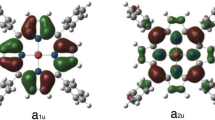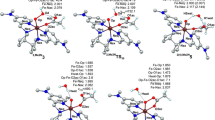Abstract
There is an intriguing, current controversy on the involvement of multiple oxidizing species in oxygen transfer reactions by cytochromes P450 and iron porphyrin complexes. The primary evidence for the “multiple oxidants” theory was that products and/or product distributions obtained in the catalytic oxygenations were different depending on reaction conditions such as catalysts, oxidants, and solvents. In the present work, we carried out detailed mechanistic studies on competitive olefin epoxidation, alkane hydroxylation, and C=C epoxidation versus allylic C–H hydroxylation in olefin oxygenation with in situ generated oxoiron(IV) porphyrin π-cation radicals (1) under various reaction conditions. We found that the products and product distributions were markedly different depending on the reaction conditions. For example, 1 bearing different axial ligands showed different product selectivities in competitive epoxidations of cis-olefins and trans-olefins and of styrene and para-substituted styrenes. The hydroxylation of ethylbenzene by 1 afforded different products, such as 1-phenylethanol and ethylbenzoquinone, depending on the axial ligands of 1 and substrates. Moreover, the regioselectivity of C=C epoxidation versus C–H hydroxylation in the oxygenation of cyclohexene by 1 changed dramatically depending on the reaction temperatures, the electronic nature of the iron porphyrins, and substrates. These results demonstrate that 1 can exhibit diverse reactivity patterns under different reaction conditions, leading us to propose that the different products and/or product distributions observed in the catalytic oxygenation reactions by iron porphyrin models might not arise from the involvement of multiple oxidizing species but from 1 under different circumstances. This study provides strong evidence that 1 can behave like a “chameleon oxidant” that changes its reactivity and selectivity under the influence of environmental changes.







Similar content being viewed by others
Abbreviations
- BDE:
-
Bond dissociation energy
- m-CPBA:
-
m-Chloroperbenzoic acid
- CYP 450:
-
Cytochrome P450
- EB:
-
Ethylbenzene
- EB-d10:
-
Ethylbenzene-d10
- EB-para-Br:
-
1-Bromo-4-ethylbenzene
- GC:
-
Gas chromatography
- GC-MS:
-
Gas chromatography–mass spectrometry
- HPLC:
-
High performance liquid chromatography
- KIE:
-
Kinetic isotope effect
- TDCPP:
-
meso-Tetrakis(2,6-dichlorophenyl)porphyrin dianion
- TDFPP:
-
meso-Tetrakis(2,6-difluorophenyl)porphyrin dianion
- TDMPP:
-
meso-Tetrakis(2,6-dimethylphenyl)porphyrin dianion
- TMP:
-
meso-Tetramesitylporphyrin dianion
- TPFPP:
-
meso-Tetrakis(pentafluorophenyl)porphyrin dianion
References
Meunier B, de Visser SP, Shaik S (2004) Chem Rev 104:3947–3980
Nam W (2003) In: Que L, Tolman WB (eds) Comprehensive coordination chemistry II, vol 8. Elsevier, Oxford, pp 281–307
McLain J, Lee J, Groves JT (2000) In: Meunier B (ed) Biomimetic oxidations catalyzed by transition metal complexes. Imperial College Press, London, pp 91–169
Sono M, Roach MP, Coulter ED, Dawson JH (1996) Chem Rev 96:2841–2887
Ortiz de Montellano PR (ed) (1995) Cytochrome P450: structure, mechanism, and biochemistry, 2nd edn. Plenum, New York
Traylor TG, Traylor PS (1995) In: Valentine JS, Foote CS, Greenberg A, Liebman JF (eds) Active oxygen in biochemistry. Blackie Academic and Professional, Chapman & Hall, London, pp 84–187
Jin S, Bryson TA, Dawson JH (2004) J Biol Inorg Chem 9:644–653
Nam W, Ryu YO, Song WJ (2004) J Biol Inorg Chem 9:654–660
Shaik S, de Visser SP, Kumar D (2004) J Biol Inorg Chem 9:661–668
Hlavica P (2004) Eur J Biochem 271:4335–4360
Groves JT (2003) Proc Natl Acad Sci USA 100:3569–3574
Newcomb M, Hollenberg PF, Coon MJ (2003) Arch Biochem Biophys 409:72–79
Coon MJ (2003) Biochem Biophys Res Commun 312:163–168
Ortiz de Montellano PR, De Voss JJ (2002) Nat Prod Rep 19:477–493
Watanabe Y (2001) J Biol Inorg Chem 6:846–856
Vaz ADN, Pernecky SJ, Raner GM, Coon MJ (1996) Proc Natl Acad Sci USA 93:4644–4648
Vaz ADN, McGinnity DF, Coon MJ (1998) Proc Natl Acad Sci USA 95:3555–3560
Vatsis KP, Coon MJ (2002) Arch Biochem Biophys 397:119–129
Newcomb M, Toy PH (2000) Acc Chem Res 33:449–455
Toy PH, Newcomb M, Coon MJ, Vaz ADN (1998) J Am Chem Soc 120:9718–9719
Newcomb M, Shen R, Choi SY, Toy PH, Hollenberg PF, Vaz ADN, Coon MJ (2000) J Am Chem Soc 122:2677–2686
Newcomb M, Shen R, Lu Y, Coon MJ, Hollenberg PF, Kopp DA, Lippard SJ (2002) J Am Chem Soc 124:6879–6886
Newcomb M, Aebisher D, Shen R, Chandrasena REP, Hollenberg PF, Coon MJ (2003) J Am Chem Soc 125:6064–6065
Chandrasena REP, Vatsis KP, Coon MJ, Hollenberg PF, Newcomb M (2004) J Am Chem Soc 126:115–126
Jin S, Makris TM, Bryson TA, Sligar SG, Dawson JH (2003) J Am Chem Soc 125:3406–3407
Volz TJ, Rock DA, Jones JP (2002) J Am Chem Soc 124:9724–9725
Nam W, Lim MH, Lee HJ, Kim C (2000) J Am Chem Soc 122:6641–6647
Nam W, Lim MH, Moon SK, Kim C (2000) J Am Chem Soc 122:10805–10809
Nam W, Lee HJ, Oh SY, Kim C, Jang HG (2000) J Inorg Biochem 80:219–225
Nam W, Jin SW, Lim MH, Ryu JY, Kim C (2002) Inorg Chem 41:3647–3652
Machii K, Watanabe Y, Morishima I (1995) J Am Chem Soc 117:6691–6697
Collman JP, Chien AS, Eberspacher TA, Brauman JI (2000) J Am Chem Soc 122:11098–11100
Wadhwani P, Mukherjee M, Bandyopadhyay D (2001) J Am Chem Soc 123:12430–12431
Suzuki N, Higuchi T, Nagano T (2002) J Am Chem Soc 124:9622–9628
Adam W, Roschmann KJ, Saha-Möller CR, Seebach D (2002) J Am Chem Soc 124:5068–5073
Collman JP, Zeng L, Decréau RA (2003) Chem Commun :2974–2975
Collman JP, Zeng L, Brauman JI (2004) Inorg Chem 43:2672–2679
Wang SH, Mandimutsira BS, Todd R, Ramdhanie B, Fox JP, Goldberg DP (2004) J Am Chem Soc 126:18–19
Shaik S, Cohen S, de Visser SP, Sharma PK, Kumar D, Kozuch S, Ogliaro F, Danovich D (2004) Eur J Inorg Chem 2:207–226
Shaik S, de Visser SP, Ogliaro F, Schwarz H, Schröder D (2002) Curr Opin Chem Biol 6:556–567
Schröder D, Shaik S, Schwarz H (2000) Acc Chem Res 33:139–145
Ogliaro F, de Visser SP, Cohen S, Sharma PK, Shaik S (2002) J Am Chem Soc 124:2806–2817
Kamachi T, Shiota Y, Ohta T, Yoshizawa K (2003) Bull Chem Soc Jpn 76:721–732
Sharma PK, de Visser SP, Shaik S (2003) J Am Chem Soc 125:8698–8699
Schöneboom JC, Cohen S, Lin H, Shaik S, Thiel W (2004) J Am Chem Soc 126:4017–4034
Dowers TS, Rock DA, Rock DA, Jones JP (2004) J Am Chem Soc 126:8868–8869
Auclair K, Hu Z, Little DM, Ortiz de Montellano PR, Groves JT (2002) J Am Chem Soc 124:6020–6027
He X, Ortiz de Montellano PR (2004) J Biol Chem 279:39479–39484
Pratt JM, Ridd TI, King LJ (1995) J Chem Soc Chem Commun 2297–2298
Lindsey JS, Wagner RW (1989) J Org Chem 54:828–836
Jockers R, Schmid RD, Rieger H, Krohn K (1991) Liebigs Ann Chem 315–321
The reaction of Fe(TPFPP)Cl with m-CPBA in a solvent mixture of CH3CN and CH2Cl2 (1:1) at −40°C did not form 3-A but (TPFPP)FeIV=O. Lowering the reaction temperature to −80°C and changing the solvent mixture to CH2Cl2 allowed us to generate and use 3-A directly in reactivity studies
Nam W, Lim MH, Oh SY, Lee JH, Lee HJ, Woo SK, Kim C, Shin W (2000) Angew Chem Int Ed 39:3646–3649
It has been well demonstrated that when oxoiron(IV) porphyrin π-cation radicals are generated by reacting iron(III) porphyrin complexes and m-CPBA, the axial ligand present in the starting iron(III) porphyrins is retained in the intermediates
Wolter T, Meyer-Klaucke W, Müther M, Mandon D, Winkler H, Trautwein AX, Weiss R (2000) J Inorg Biochem 78:117–122
Fujii H, Yoshimura T, Kamada H (1997) Inorg Chem 36:6142–6143
Czarnecki K, Nimri S, Gross Z, Proniewicz LM, Kincaid JR (1996) J Am Chem Soc 118:2929–2935
The cis-olefin selectivity resulted from the steric effect of porphyrin ligands has been reported previously
Groves JT, Nemo TE (1983) J Am Chem Soc 105:5786–5791
Hammett ρ+ value of −1.9 was reported in the kinetic studies of [(TMP)+· FeIV=O]+ and styrens, whereas Hammett ρ+ value of −0.9 was determined in the catalytic competitive epoxidation of styrene and para-substituted styrenes by iron(III) porphyrin chlorides and PhIO. The different Hammett ρ+ values observed previously are now rationalized with the axial ligand effect discussed in this paper
Groves JT, Watanabe Y (1986) J Am Chem Soc 108:507–508
Lindsay Smith JR, Sleath PR (1982) J Chem Soc Perkin Trans II :1009–1015
Traylor TG, Xu F (1988) J Am Chem Soc 110:1953–1958
Gross Z, Nimri S (1994) Inorg Chem 33:1731–1732
Gross Z, Nimri S, Barzilay CM, Simkhovich L (1997) J Biol Inorg Chem 2:492–506
The formation of quinone product has been often observed in the hydroxylation of aromatic compounds by metalloporphyrins
Song R, Sorokin A, Bernadou J, Meunier B (1997) J Org Chem 62:673–678
Khavasi HR, Davarani SSH, Safari N (2002) J Mol Catal A Chem 188:115–122
Atkinson JK, Hollenberg PF, Ingold KU, Johnson CC, Le Tadic MH, Newcomb M, Putt DA (1994) Biochemistry 33:10630–10637
Kumar D, de Visser SP, Sharma PK, Cohen S, Shaik S (2004) J Am Chem Soc 126:1907–1920
Kumar D, de Visser SP, Shaik S (2003) J Am Chem Soc 125:13024–13025
Ogliaro F, Filatov M, Shaik S (2000) Eur J Inorg Chem 12:2455–2458
Martinis SA, Atkins WM, Stayton PS, Sligar SG (1989) J Am Chem Soc 111:9252–9253
Imai M, Shimada H, Watanabe Y, Matsushima-Hibiya Y, Makino R, Koga H, Horiuchi T, Ishimura Y (1989) Proc Natl Acad Sci USA 86:7823–7827
Vidakovic M, Sligar SG, Li H, Poulos TL (1998) Biochemistry 37:9211–9219
Groves JT, Gross Z, Stern MK (1995) In: Kessissoglon DP (ed) Bioinorganic chemistry: an inorganic perspective of life. NATO Advanced Study Institute Series 459. Kluwer, The Netherlands, pp39–47
Farinas ET, Alcalde M, Arnold F (2004) Tetrahedron 60:525–528
Lim MH, Jin SW, Lee YJ, Jhon GJ, Nam W, Kim C (2001) Bull Korean Chem Soc 22:93–96
Ohno T, Suzuki N, Dokoh T, Urano Y, Kikuchi K, Hirobe M, Higuchi T, Nagano T (2000) J Inorg Biochem 82:123–125
Bartoli JF, Brigaud O, Battioni P, Mansuy D (1991) J Chem Soc Chem Commun :440–442
Ruettinger RT, Fulco AJ (1981) J Biol Chem 256:5728–5734
Traylor TG, Kim C, Richards JL, Xu F, Perrin CL (1995) J Am Chem Soc 117:3468–3474
A reviewer suggested that the high reactivity of allylic C–H bonds of cyclohexene, compared to those of cyclooctene, is due to that the allylic C–H bonds are parallel to the π-bond of olefin
de Visser SP, Ogliaro F, Sharma PK, Shaik S (2002) J Am Chem Soc 124:11809–11826
de Visser SP, Ogliaro F, Sharma PK, Shaik S (2002) Angew Chem Int Ed 41:1947–1951
Shaik S, de Visser SP, Kumar D (2004) J Am Chem Soc 126:11746–11749
Groves JT, Haushalter RC, Nakamura M, Nemo TE, Evans BJ (1981) J Am Chem Soc 103:2884–2886
Davydov R, Perera R, Jin S, Yang TC, Bryson TA, Sono M, Dawson JH, Hoffman BM (2005) J Am Chem Soc 127:1403–1413
Acknowledgement
This research was supported by the Ministry of Science and Technology of Korea through the Creative Research Initiative Program.
Author information
Authors and Affiliations
Corresponding author
Electronic Supplementary Material
Rights and permissions
About this article
Cite this article
Song, W.J., Ryu, Y.O., Song, R. et al. Oxoiron(IV) porphyrin π-cation radical complexes with a chameleon behavior in cytochrome P450 model reactions. J Biol Inorg Chem 10, 294–304 (2005). https://doi.org/10.1007/s00775-005-0641-9
Received:
Accepted:
Published:
Issue Date:
DOI: https://doi.org/10.1007/s00775-005-0641-9




